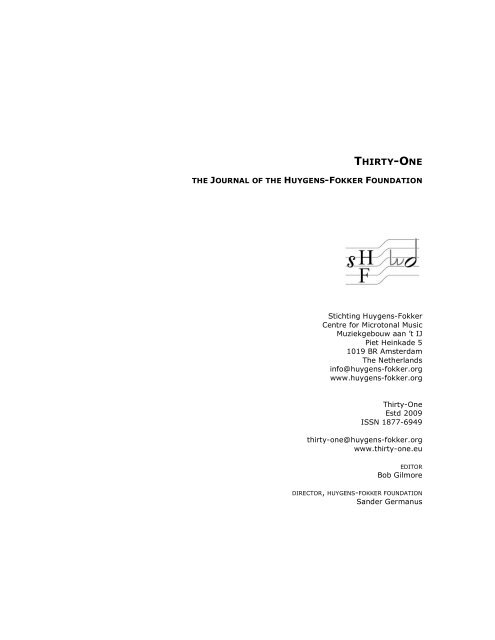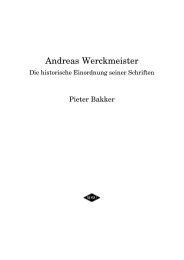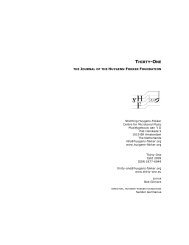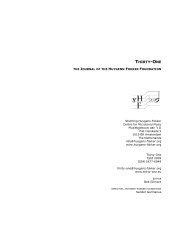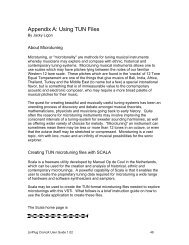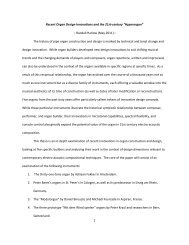Some Thoughts on Linear Microtonality - Frank Denyer - Stichting ...
Some Thoughts on Linear Microtonality - Frank Denyer - Stichting ...
Some Thoughts on Linear Microtonality - Frank Denyer - Stichting ...
You also want an ePaper? Increase the reach of your titles
YUMPU automatically turns print PDFs into web optimized ePapers that Google loves.
THIRTY-ONETHE JOURNAL OF THE HUYGENS-FOKKER FOUNDATION<strong>Stichting</strong> Huygens-FokkerCentre for Microt<strong>on</strong>al MusicMuziekgebouw aan ’t IJPiet Heinkade 51019 BR AmsterdamThe Netherlandsinfo@huygens-fokker.orgwww.huygens-fokker.orgThirty-OneEstd 2009ISSN 1877-6949thirty-<strong>on</strong>e@huygens-fokker.orgwww.thirty-<strong>on</strong>e.euEDITORBob GilmoreDIRECTOR, HUYGENS-FOKKER FOUNDATIONSander Germanus
CONTENTSVOL.1 (SUMMER 2009)EDITORIAL 4Bob GilmoreMICRO-ACTUALITIES / MICROACTUALITEITEN 5Sander GermanusCOMPOSITION FORUMHOW I BECAME A CONVERT: ON THE USE OF MICROTONALITY, TUNING & OVERTONE SYSTEMS IN MYRECENT WORK 8Peter AdriaanszSOME THOUGHTS ON LINEAR MICROTONALITY 34<strong>Frank</strong> <strong>Denyer</strong>KEY ECCENTRICITY IN BEN JOHNSTON’S SUITE FOR MICROTONAL PIANO 42Kyle GannTHEORY FORUMTHE HUYGENS COMMA: SOME MATHEMATICS CONCERNING THE 31-CYCLE 49Giorgio Dill<strong>on</strong> and Riccardo MusenichINSTRUMENT FORUMTECHNISCHE ASPECTEN VAN HET 31-TOONS-ORGEL, 1950-2009 57Cees van der PoelREVIEWSREVIEW OF PATRIZIO BARBIERI: ENHARMONIC INSTRUMENTS AND MUSIC 1470-1900 61Rudolf RaschREVIEW OF BOZZINI QUARTET: ARBOR VITAE (JAMES TENNEY: QUATUORS + QUINTETTES) 66Bob GilmoreNOTES ON CONTRIBUTORS 69
SOME THOUGHTS ON LINEAR MICROTONALITY<strong>Frank</strong> <strong>Denyer</strong>The growing use of microt<strong>on</strong>al intervals in compositi<strong>on</strong> has influenced and been influenced bydiverse forms of pitch analyses. This has, by and large, c<strong>on</strong>centrated <strong>on</strong> aspects of theharm<strong>on</strong>ic series, often advocating its authority as the most ‘rati<strong>on</strong>al’ or ‘scientific’ foundati<strong>on</strong>for understanding musical scales. In such work musical intervals have been described as ‘true’when they c<strong>on</strong>formed to mathematical ratios that dem<strong>on</strong>strated their precise place andderivati<strong>on</strong> in the model. This has opened up new areas of enquiry but has also led such workto be unusually susceptible to academic pedantry. The harm<strong>on</strong>ic series, because it is‘harm<strong>on</strong>ic’, is made up of intervals that are most acutely appreciated when their comp<strong>on</strong>entnotes are heard as simultaneities.In my own work I have approached microt<strong>on</strong>al issues from a different viewpoint, focusingprimarily <strong>on</strong> the percepti<strong>on</strong> of linear microt<strong>on</strong>al relati<strong>on</strong>ships. For reas<strong>on</strong>s that will becomeapparent, the two perspectives do not have many points of c<strong>on</strong>vergence. The fact is that ourhuman percepti<strong>on</strong> of micro-intervals is c<strong>on</strong>siderably altered when we hear the c<strong>on</strong>stituentnotes linearly (i.e. <strong>on</strong>e after the other) rather than simultaneously, a fact that can be easilyverified in the studio.The linear investigati<strong>on</strong> I advocate is not based <strong>on</strong> an extracted set of mathematicalrelati<strong>on</strong>ships but <strong>on</strong> the observati<strong>on</strong>s of our perceptual intelligence allied to the unaidedcapacities of the human ear and the interpretati<strong>on</strong> of its data by the brain. So much of ourhearing is interdependent with other mental functi<strong>on</strong>s that we must take the whole skeintogether, and there can be no excuse for excluding awkward aspects of listening – such as theinherent capacity to privilege certain aural informati<strong>on</strong>, or the propensity for mispercepti<strong>on</strong>and aural illusi<strong>on</strong> due to the natural limitati<strong>on</strong>s of the sensory organs and the associatedprocessing. Neither should we devalue the ability of such a complex web to trigger resp<strong>on</strong>sesin far flung neural networks of the brain, because that is exactly what gives sound itsunrivalled suggestibility and essentially its capacity to become music.Let us first c<strong>on</strong>sider <strong>on</strong>e tiny piece of actual perceptual evidence. Laboratory data shows thateven primary intervals from the harm<strong>on</strong>ic series, such as the octave or fifth, when heardlinearly, are usually judged by musicians as being ‘completely in tune’ <strong>on</strong>ly after theirharm<strong>on</strong>ic identity has been slightly modified, most often by making them a few cents narrowerthan that produced by the pure ratios. In a test I c<strong>on</strong>ducted at WesleyanUniversity in 1977, two tunable oscillators were set up in such a way that when either <strong>on</strong>e wassounding the other was switched off. Thirty-five musicians attended individually and each wasasked to tune <strong>on</strong>e oscillator to a perfect fifth or an octave above the other, but they couldnever hear both notes simultaneously. However, they were free to go back and forth betweenthe oscillators any number of times, and no time limit was imposed. Interestingly, theresulting (melodic) intervals were, <strong>on</strong> average, tuned flatter than their harm<strong>on</strong>ic counterparts.This appeared to dem<strong>on</strong>strate two different ways of being ‘in tune’. The questi<strong>on</strong> is: being intune with what? Historically there have been, and may still be, many different but equallylegitimate answers to this questi<strong>on</strong>. I also cannot fail to notice that my own temperamentleads me to feel comfortable when I recognise an inner point of ultimate reference, with thepower to at least modify the rigid applicati<strong>on</strong> of externally imposed rules (much as the
individual c<strong>on</strong>science is a significant factor to judgments of guilt or innocence in modern legalsystems; when laws are absolute and their advocates cannot imagine circumstances wherethey might be modified, the result is tyranny).Being in tune. Whatever it is we wish to be in tune with – whether an internal or externalreality, the Indian atman or the Chinese huang chung (yellow bell), the voice of God, lay lines,the basic laws of the physical envir<strong>on</strong>ment or merely our own inner nature –whatever it is,humankind has periodically become c<strong>on</strong>vinced that a superior form of music could berealisable, and <strong>on</strong>e with unique revelatory potential, if <strong>on</strong>ly sufficiently rigorous efforts weremade to re-establish pitch as music’s deepest underlying fundamental. We seem to havecarried this perennial desire to purify music so that it might better reflect a more perfectexistence, perhaps even transmit knowledge of the divine itself or allow us to experience thesounds from a remote heavenly sphere, or just the essence of a byg<strong>on</strong>e golden age, or atleast intimati<strong>on</strong>s of a life more perfect than the <strong>on</strong>e we now experience. Sadly, the holy grailremains elusive and as with many religious or political aspirati<strong>on</strong>s, the results never seem tosucceed as potently as had been hoped. The quest, like that of the grail, partially fails. Forsome this inevitably triggers demands for the applicati<strong>on</strong> of even more rigorous tuningtheories. For others, such perfecti<strong>on</strong> remains to be found <strong>on</strong>ly in the dream of an unheard,silent or unstruck music, perfect because unrealised. Numerous world traditi<strong>on</strong>s are litteredwith tragic memorials that celebrate both sides of this divide.In our own fragmented, individualistic and uncertain times perhaps we must be c<strong>on</strong>tent withmusic that is just in tune with itself (oh, those w<strong>on</strong>derful unis<strong>on</strong>s), but even then all is nothealth and fitness, for it still remains for us to find some practical accommodati<strong>on</strong> between thetuned and the out of tune. In other societies the latter has frequently been treated withextreme cauti<strong>on</strong> and special roles devised even for its marginal inclusi<strong>on</strong>. Not <strong>on</strong>ly roles butrules, their precise nature and scope being almost as diverse as humanity itself. In some formthese have been formulated <strong>on</strong> every c<strong>on</strong>tinent in almost every era. Incorporating notes thatare in tune with others which are out of tune has implicati<strong>on</strong>s that reach far bey<strong>on</strong>d music,suggesting parallels with social definiti<strong>on</strong>s of ‘bel<strong>on</strong>ging’ and ‘not bel<strong>on</strong>ging’, the sacred andthe secular, the insider and the foreigner, the civilized and the primitive, the professi<strong>on</strong>al andthe amateur, the true and the false, or even the role of comfort and discomfort in a particularlife-view.In practice, this interface between the tuned and untuned may be extended from a sharp butcrude divisi<strong>on</strong> between good and evil to the additi<strong>on</strong> of a more ambiguous but fertile no-man’sland between them, or even to a complete gradati<strong>on</strong> of values with the poles <strong>on</strong>ly as smallrarified points <strong>on</strong> either end. In such circumstances the practical musician finds that being intune or out of tune is not a mathematically fixed issue, but <strong>on</strong>e that requires the negotiati<strong>on</strong>of a subtle path between the physical capabilities of musical instruments and the limitati<strong>on</strong>s ofthe human ear while still remaining susceptible to wider aesthetic imperatives. This relates tomany aspects of music making and not merely performance itself. Here is <strong>on</strong>e very specificcase: comparing a piano that has been tuned with an electr<strong>on</strong>ic tuner to <strong>on</strong>e tuned by ear, it isclear that the exact type and degree of variati<strong>on</strong> between these two methods remains an issuefor musical discussi<strong>on</strong> and pers<strong>on</strong>al judgment.The first vague glimpse of this matrix of interc<strong>on</strong>necti<strong>on</strong>s started to float into my mind in theearly seventies. I had noticed that open-holed woodwind instruments, whether from Europe orAsia, could create remarkably fluid and organic melodic c<strong>on</strong>tinuities, but that these featureswere diminished when the player performed the same phrases, with similar articulati<strong>on</strong>, <strong>on</strong> thestandard silver flute, even though paradoxically the latter had the capacity to produce notesthat were said to be more in tune. Open-holed instruments allowed a rounding of certainintervals precisely because the int<strong>on</strong>ati<strong>on</strong> was more malleable and it was clear that anexperienced player took full advantage of this. I c<strong>on</strong>cluded that late 19th/ early 20th centuryEuropean woodwind instruments, with their greater uniformity of bore, accuracy in thelocati<strong>on</strong> and size of finger-holes, precisi<strong>on</strong> key mechanisms, not to menti<strong>on</strong> developments ofmouth plates and reeds, might be less resp<strong>on</strong>sive to my particular aspirati<strong>on</strong>s as a composer,searching as I already was for a melodic line inherently softer, flexible and more fluid than anyI had yet come across.
Therefore, when writing my piece After the Rain (1983) and trying to envisage asuitable ensemble that might support a solo shakuhachi and solo violin, I chose three ocarinasand percussi<strong>on</strong>, partly because the ocarina had a particularly large number of variables thataffected pitch, and this unpredictability tended to create a soft edged int<strong>on</strong>ati<strong>on</strong>. This wasfurther reinforced by the instrument’s soft attack and overall dynamic level. It could have beenargued that this tactic would merely produce a certain randomness of int<strong>on</strong>ati<strong>on</strong>, but Ic<strong>on</strong>sidered that this uncertainty might already go some way towards modifying the hardedgedpitch-tyranny with which I was surrounded and from which I was trying to liberatemyself.Such experiences were indeed liberating and so<strong>on</strong> I was able to grasp some more focusedspecifics. For example, I found that in a linear c<strong>on</strong>text, flattening an harm<strong>on</strong>ic interval by afew cents would soften its outline and when melodic intervals like octaves, fifths and fourthswere treated in this way, there was also a greater propensity for the two notes to bindthemselves together as a unit, an important factor when attempting to make coherent melodicwholes.The opposite tendency occurred when a primary interval was slightly widened. The sharpeningof an interval increased its outward movement and it appeared brighter and more energeticthan it would otherwise. Here there was a tendency for the notes to separate and the linearb<strong>on</strong>ds that link them to weaken. (In a real musical c<strong>on</strong>text there may be other factors thatnullify both c<strong>on</strong>siderati<strong>on</strong>s. It is well to remember that harm<strong>on</strong>ic c<strong>on</strong>tent is particularly potentin this respect.)If narrowing were to be compared to a visual artist rounding off the corners of a square,rectangle or triangle, then randomly mixing, narrowing and widening would be more likedrawing geometrical shapes ‘by hand’. Neither affects the fundamental identity of the shapesthemselves, but compared with the hard, precisely delineated figures drawn with ruler andcompass, they appear less rigid, more inherently flexible, and so more ‘humane’ perhaps.Such adjustments of int<strong>on</strong>ati<strong>on</strong> all occur at the micro-level. But it is precisely at this levelwhere another facet becomes inter-c<strong>on</strong>nected. In a linear c<strong>on</strong>text, the very tiniest changes offrequency (less than five or six cents) appear not as pitch alterati<strong>on</strong>s at all, but are heard aschanges of timbre. In the other directi<strong>on</strong> it follows that a particular timbre change might havean impact <strong>on</strong> our linear pitch percepti<strong>on</strong>. This suggests that instrumentati<strong>on</strong> may activelyaffect int<strong>on</strong>ati<strong>on</strong> judgments.At this point we might pause to c<strong>on</strong>sider the distincti<strong>on</strong> between ‘pitch’ and ‘note’. When theBerlin Philharm<strong>on</strong>ic decides to raise its standard pitch very slightly (which they doperiodically), clearly the musicians themselves c<strong>on</strong>tinue to play the same notes as before. Ifthe pitch of an unaccompanied singer gradually becomes sharper during the course of a piece,the actual notes remain the same although their individual frequencies may be increasing.While working in Kenya’s Kerio Valley I noticed that lyre players could c<strong>on</strong>sider two strings tohave an octave relati<strong>on</strong>ship and be acceptably in tune even when <strong>on</strong>e of them was more thana hundred cents away from the 2:1 harm<strong>on</strong>ic ratio. This is probably because they employ agamut of just five notes, somewhat casually spread out between the octave, so the identity ofadjacent notes is never compromised, and the essential pitch relati<strong>on</strong>ships remain the same,making them indeed in tune. In all three cases outlined above, the musical c<strong>on</strong>text hasmaintained the structural functi<strong>on</strong> of the notes and they are not c<strong>on</strong>sidered as having beenaltered.Thus arises an interesting questi<strong>on</strong> which has l<strong>on</strong>g fascinated me. What particular musicalc<strong>on</strong>diti<strong>on</strong>s might I create that would allow a very slight frequency change to be perceived as adistinctly different note rather than a variant of the same note; and how, <strong>on</strong> the other hand,could I make a significant frequency change of perhaps more than a hundred cents seem likethe same note? The following example from Tentative <str<strong>on</strong>g>Thoughts</str<strong>on</strong>g>, Silenced Voices (2002-3)illustrates how I have dealt with this and other related issues in practice (Figure 1). (A key tothe accidentals I use for microt<strong>on</strong>es is given in Figure 2.)
Figure 1: <strong>Denyer</strong>, Tentative <str<strong>on</strong>g>Thoughts</str<strong>on</strong>g>, Silenced Voices page 4, bars 1-9; © 2003, <strong>Frank</strong><strong>Denyer</strong>The play between the semit<strong>on</strong>e sharp f1 in the viola and the last note of the two male singers(a sixth-t<strong>on</strong>e flat g1) is first heard as two versi<strong>on</strong>s of the same note, although it is certainlywide enough to be perceived as a pitch change and not a timbre change. The voice note isdisguised by first appearing merely as the end of a small glissando. Subsequently (bar 2)these notes are repeated in alternati<strong>on</strong> between the viola (sharp f1) and the first male voice
(sixth-t<strong>on</strong>e flat g1), and then in bar 3 between the viola and the c<strong>on</strong>certina reed, and finallyspread out over the whole of bars 4 and 5. During these four bars (bars 2-5) percepti<strong>on</strong> hasbeen gradually changing from what appears to be two versi<strong>on</strong>s of the same note, to two quiteseparate notes in oppositi<strong>on</strong>. The upper <strong>on</strong>e is then taken up by the violin an octave higher(sixth-t<strong>on</strong>e flat g2) as the starting point for the next musical paragraph, which moves off witha more c<strong>on</strong>fident melodic intent through the interval of a falling perfect fifth, albeit narrowedby a sixth-t<strong>on</strong>e. The violin adds the next five notes that are purely diat<strong>on</strong>ic (bar 6) butaccompanied by the santur with quarter-t<strong>on</strong>e shifts. The latter do not appear as variants ofeach other as <strong>on</strong>e might expect, or as triadic blurring, but as a definite stepwise movement,partly because the santur is muted to reduce its echo-like res<strong>on</strong>ance. The main melody istransferred to the viola (bar 7), creating a subtle timbre change, and immediately thereafter aquarter-t<strong>on</strong>e vibrato-like ornament is heard that is obviously a single note despite its pitchalterati<strong>on</strong>s. The additi<strong>on</strong> of the rubbed clothboard to this particular viola note also helpssmudge the variati<strong>on</strong>s in frequency.Figure 2: accidentals for microt<strong>on</strong>es used in scores by <strong>Frank</strong> <strong>Denyer</strong>Over the years I have accumulated a collecti<strong>on</strong> of simple pitched and n<strong>on</strong>-pitched percussi<strong>on</strong>instruments whose sounds are produced by fricti<strong>on</strong>. (Fricti<strong>on</strong> percussi<strong>on</strong> is somewhatundeveloped in the western instrumentarium, so there are gaps that need filling and scope forexperiment.) As in the musical example above, n<strong>on</strong>-pitched fricti<strong>on</strong> percussi<strong>on</strong> instrumentscan act as useful adjuncts to pitched instruments, as well as having their own inherentcharacter. A flute, for instance, with its almost sine-wave purity may be easily modified bynoise elements from the player’s voice or breath, but fricti<strong>on</strong> percussi<strong>on</strong> instruments allow thisprocess to be c<strong>on</strong>siderably intensified.As a more subtle example of linear microt<strong>on</strong>al thinking I would like to turn to the opening ofmy piece Ghosts Again (2005) (Figure 3).
Figure 3: <strong>Denyer</strong>, Ghosts Again page 1, bars 1- 5; © 2005, <strong>Frank</strong> <strong>Denyer</strong>The piece starts with a melodic arc that can be thought of as an elaborate anacrusis leadingthe ear forward to the note d3 (bar 2) which, as in the previous example, is first introduced<strong>on</strong>ly as the end of a glissando, but which is then more firmly established by being repeated.The main purpose of this anacrusis is to imbue d3, when it arrives, with a floating, un-rootedand somewhat strange character difficult to describe. I’ll try to outline how this happens. Theclarinet opens with an upward legato minor third that is flattened by <strong>on</strong>e-sixth of a t<strong>on</strong>e. Thisflattening softens and c<strong>on</strong>strains the interval but at the same time gives it an inner tendencyto expand outwards, which it does after it has been taken up by the violin (expanding from asixth-t<strong>on</strong>e sharp c1 to a two-thirds flat d1). From there it sweeps upwards in a l<strong>on</strong>g andunexpected curve that is t<strong>on</strong>ally disorienting, especially as it comes to rest <strong>on</strong> a strange twothirdssharp a2 that is immediately ‘corrected’ by a very slightly sharpened versi<strong>on</strong> of thissame note (a quarter-flat b2). At this juncture the ear is naturally c<strong>on</strong>fused, but the perfectfourth leap up to the first beat of the following bar helps put firm t<strong>on</strong>al ground beneath ourfeet, despite the fact that the fourth is slightly widened by approximately 16 cents (fromquarter-t<strong>on</strong>e flat b2 to a sixth-t<strong>on</strong>e flat e3). However, this sharpening pulls us back to a truerperfect fourth (quarter-t<strong>on</strong>e flat e3), although any security gained is quite fleeting because thenote c<strong>on</strong>tinues to slide until it finally arrives <strong>on</strong> the all important d3. The latter now seemsstrange because, since the opening, the ear has been made to readjust its basic t<strong>on</strong>alorientati<strong>on</strong> microt<strong>on</strong>ally and this point of arrival is unrelated to any of the events immediatelypreceding it (but closely related to where we originally began with the first clarinet note). Andso the pitch appears in all its oddness. This is crucial for what follows as the next few minutesare entirely taken up with its further adventures that evolve out of that uncertainty.Although in this paper it is <strong>on</strong>ly possible to touch briefly <strong>on</strong> some simple aspects of thisterrain, I would nevertheless like to add some thoughts about training and preparati<strong>on</strong>. Forme, unusual intervals are <strong>on</strong>ly viable after they have been completely internalised by theperformer. This means more than merely being able to mimic them and implies that they havebeen absorbed into the substrata of the artist’s subc<strong>on</strong>scious. Is this asking too much? If not,how can it be achieved?A culturally shared collecti<strong>on</strong> of musical pitch relati<strong>on</strong>ships is already an inner part of eachindividual’s life from very early childhood. As such they act as a foundati<strong>on</strong> for the laterassimilati<strong>on</strong> of musical experiences. This pitch repertoire slowly expands as the child maturesbut for those that are active as musicians, this development is faster and much moreextensive. All intervals have the potential to accrue variants or modificati<strong>on</strong>s that can becomedeeply embedded by reference to familiar musical c<strong>on</strong>texts and it is not uncomm<strong>on</strong> formodified intervals to be used as a measure of stylistic authenticity. (The precise pitching ofblue notes in jazz would be <strong>on</strong>e obvious case but all genres are riddled with them; indeed at amore refined level it may be that the majority of notes fall into this category.) To give another


